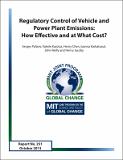| dc.contributor.author | Paltsev, S. | |
| dc.contributor.author | Karplus, V. | |
| dc.contributor.author | Chen, Y.-H.H. | |
| dc.contributor.author | Karkatsouli, I. | |
| dc.contributor.author | Reilly, J.M. | |
| dc.contributor.author | Jacoby, H.D. | |
| dc.date.accessioned | 2013-10-17T16:50:03Z | |
| dc.date.available | 2013-10-17T16:50:03Z | |
| dc.date.issued | 2013-10 | |
| dc.identifier.uri | http://hdl.handle.net/1721.1/81415 | |
| dc.description.abstract | Passenger vehicles and power plants are major sources of greenhouse gas emissions. While economic analyses generally indicate that a broader market-based approach to greenhouse gas reduction would be less costly and more effective, regulatory approaches have found greater political success. Vehicle efficiency standards have a long history in the U.S and elsewhere, and the recent success of shale gas in the U.S. leads to a focus on coal–gas fuel switching as a way to reduce power sector emissions. We evaluate a global regulatory regime that replaces coal with natural gas in the electricity sector and imposes technically achievable improvements in the efficiency of personal transport vehicles. Its performance and cost are compared with other scenarios of future policy development including a no policy world, achievements under the Copenhagen accord, and a price-based policy to reduce global emissions by 50% by 2050. The assumed regulations applied globally achieve a global emissions reduction larger than projected for the Copenhagen agreements, but they do not prevent global GHG emissions from continuing to grow, and the reduction in emissions is achieved at a high cost compared to a price-based policy. Diagnosis of the reasons for the limited yet high-cost performance reveals influences including the partial coverage of emitting sectors, small or no influence on the demand for emissions-intensive products, leakage when a reduction in fossil use in the covered sectors lowers the price to others, and the partial coverage of GHGs. | en_US |
| dc.description.sponsorship | We thank BP for their support of this study. The MIT Integrated Global System Model (IGSM) and its economic component used in the analysis, the Emissions Prediction and Policy Analysis (EPPA model, are supported by a consortium of government, industry and foundation sponsors of the MIT Joint Program on the Science and Policy of Global Change, including U.S.
Department of Energy, Office of Science (DE-FG02-94ER61937). For a complete list of sponsors see http://globalchange.mit.edu/sponsors/current.html. | en_US |
| dc.language.iso | en_US | en_US |
| dc.publisher | MIT Joint Program | en_US |
| dc.relation.ispartofseries | MIT Joint Program Report Series;Report 251 | |
| dc.title | Regulatory Control of Vehicle and Power Plant Emissions: How Effective and at What Cost? | en_US |
| dc.type | Technical Report | en_US |
| dc.identifier.citation | Report 251 | en_US |
